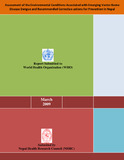Please use this identifier to cite or link to this item:
https://hdl.handle.net/20.500.14356/438| Title: | Assessment of the Environmental Conditions Associated with Emerging Vector Borne Disease Dengue and Recommended Corrective actions for Prevention in Nepal |
| Authors: | Nepal Health Research Council (NHRC), Ramshah Path, Kathmandu, Nepal |
| Issue Date: | 2009 |
| Publisher: | Nepal Health Research Council |
| Keywords: | Vector Borne Disease |
| Abstract: | Introduction: Dengue is a climate sensitive vector borne diseases, which in recent years has become a public health concern. Dengue is transmitting in tropical and sub-tropical regions around the world, predominantly in urban and suburban areas (WHO Fact Sheet 2006). Domestic Dengue virus(DV) infection occurs in more than 100 countries and over 2.5 billion people live in the areas with a risk of dengue virus infection( WHO,1999,2002) Up to 100 million cases of Dengue fever( DF) and 500,000 cases of Dengue Hemorrhagic Fever (DHF) and several thousands deaths are estimated to occur annually worldwide (WHO). During the past decades, dengue virus emerged in South Asia and DF/DHF epidemics occurred in Bhutan, India, Maldives, Bangladesh and Pakistan (WHO, 2007). The global prevalence of dengue has grown dramatically in the recent decades.The principal vector of dengue virus is the mosquito Aedes aegypti.Dengue virus is maintained in a cycle between humans and Aedes aegypti,domestic day biting mosquitoes. There is limited information available on dengue viral infection in Nepal. In Nepal, the first case of dengue was reported in 2004 from Chitwan district ( Pandey et al 2004). Sporadic cases were reported since 90's in a Japanese travellar who visited Nepal and developed DF after returning to Japan. Outbreak of Dengue has been reported every year in Nepal since 2006. From August through November 2006, the number of febrile patients increased in four major hospitals in the Terai region of Nepal: Nepalgunj Medical College, Bheri Zonal Hospital in Nepalgunj, Tribhuvan Hospital in Dang and Narayani subregional hospital in Birgunj. Patients with severe symptoms were referred to Sukraraj Tropical and Infectious Diseases Hospital, Kathmandu for diagnosis and treatment. The clinical featuresin most patients were consistent with the signs of DF ( Pandey et al, 2008). It is important to assess the changes in the environmental conditions, increased vector densities associated with the A. aegypti and develop some corrective manual which help to control the vectors in communities and apply preventive approaches for such diseases among the public. |
| URI: | http://103.69.126.140:8080/handle/20.500.14356/438 |
| Appears in Collections: | NHRC Research Report |
Items in DSpace are protected by copyright, with all rights reserved, unless otherwise indicated.

